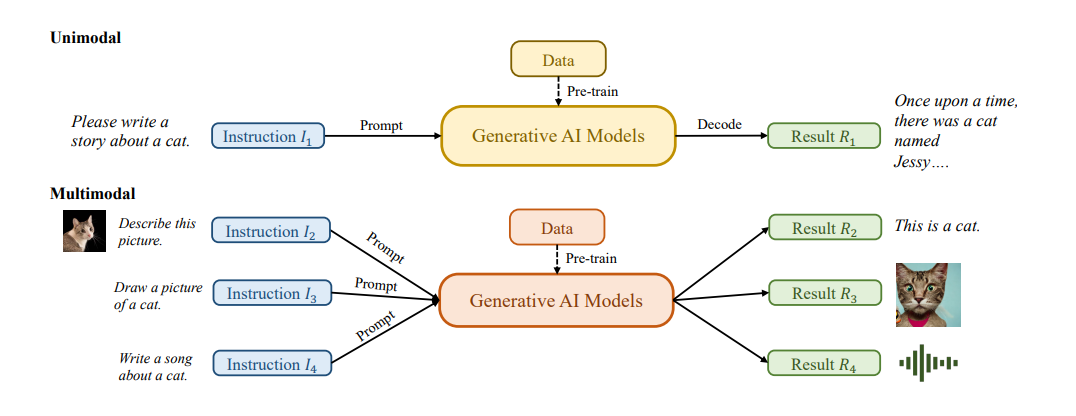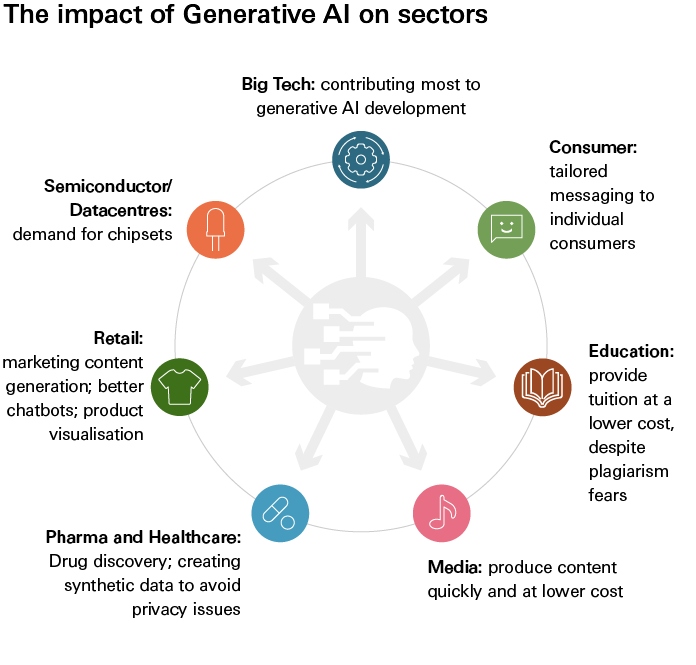TECHNOLOGY
Unleashing the Power of Generative AI

Generative AI has propelled innovation to new dimensions by enabling machines to create content, mimic human behaviors, and contribute to creative endeavors.
Rooted in neural networks, generative AI employs deep learning algorithms to generate outputs that imitate existing data patterns or produce entirely new and imaginative outcomes. This article unravels the multifaceted capabilities of generative AI and delves into its applications across various domains, highlighting its potential to reshape industries and redefine human-machine collaboration.
Understanding Generative AI: From Adversarial Networks to Variational Autoencoders

At the core of generative AI lie two prominent architectures: Generative Adversarial Networks (GANs) and Variational Autoencoders (VAEs). GANs operate through a competition between two neural networks—a generator and a discriminator—where the generator crafts data to deceive the discriminator, resulting in the creation of authentic-looking outputs. VAEs, on the other hand, work on probabilistic models to decode latent variables, allowing for controlled generation of data that adheres to specific attributes.
Revolutionizing Image Generation and Style Transfer
Generative AI has revolutionized image synthesis, enabling the creation of photorealistic images that defy detection from their authentic counterparts. Style transfer techniques leverage generative models to imbue images with artistic styles, facilitating the transformation of photographs into vivid works of art. Moreover, generative AI has empowered the development of image-to-image translation, facilitating transformations between different visual domains while preserving essential content.
Crafting Coherent Texts and Dialogues
The prowess of generative AI extends to natural language generation, generating coherent and contextually relevant text. Language models such as GPT-3 have demonstrated the ability to produce human-like narratives, summaries, and even engage in dialogue interactions. This has implications across industries, from automated content creation to virtual assistants that engage users in seamless conversations.
Innovating Beyond Creation and Design
Generative AI transcends mere replication and imitation, venturing into the realm of novel creation.

By training on vast datasets, these models can generate entirely new content, such as artwork, music compositions, and even scientific discoveries. This capacity to extrapolate from existing data patterns introduces a novel dimension of innovation and creativity.
Challenges and Ethical Considerations of Generative AI
While generative AI holds immense promise, it is not without its challenges. The potential for generating misleading or malicious content raises ethical concerns. Ensuring the responsible use of generative AI requires robust safeguards to prevent misuse and misinformation propagation.
What’s Next with Generative AI?
In the ever-evolving landscape of artificial intelligence, a revolutionary force is reshaping the boundaries of innovation – Generative AI.
This trend holds the potential to transform industries, redefine workflows, and usher in an era of unparalleled progress. In a recent CXO Spice show, I had the privilege of hosting an illuminating conversation with Mindy Cancila, Vice President of Corporate Strategy at Dell Technologies. We set forth on an expedition into the realm of Generative AI, delving into its significant ramifications for both business and society on a grand scale.
Here are my key takeaways:
-
Strategic Integration for Industry Disruption: Dell is at the forefront of embracing Generative AI for strategic industry disruption. By forming strategic partnerships and alliances, Dell is engineering solutions that elevate customer experiences while streamlining operational efficiency. As Mindy aptly emphasized, adopting Generative AI transcends mere technology – it’s about reshaping entire industries.
-
Proactive Technology Adoption: In the swiftly evolving tech landscape, staying ahead is paramount. Dell’s proactive approach to technology adoption ensures their soutions are at the pinnacle of innovation. Mindy underscored the significance of charting a clear strategic path, identifying specific use cases, and embarking on deliberate steps for non-mission-critical initiatives. This transformative journey holds the promise of remarkable outcomes.
-
Customized Solutions for Diverse Industries: Industries are as diverse as the challenges they face. Dell’s acumen lies in tailoring AI solutions to address unique industry needs. This bespoke approach empowers Dell to deliver impactful outcomes across a spectrum of sectors – from manufacturing to healthcare and beyond.
-
Data Privacy and Security: In an era defined by the AI revolution, data privacy and security are paramount. Dell’s unwavering commitment to safeguarding customer data and nurturing trust takes center stage. Mindy delved into the intersection of Generative AI with workforce diversity and culture. Responsible AI deployment transcends technology, encapsulating the alignment of AI models with values of diversity, equity and inclusion.
-
Driving Cultural Shifts: Generative AI is a catalyst not only for industry transformation but also for cultural shifts within organizations. By infusing diverse perspectives and values into AI training, Dell aims to craft models that mirror their commitment to fostering diversity, equity, and inclusion. This trailblazing approach exemplifies technology’s potential to drive positive change beyond its immediate applications.
Envisioning a world defined by more intelligence and less artificiality. As we progress towards this ideal, Generative AI stands as a beacon of this transformation. My conversation with Mindy offers a glimpse into how Dell is navigating this dynamic landscape, with Generative AI serving as a pivotal catalyst. Stay tuned for more thought-provoking discussions, insights, and updates on the remarkable potential of Generative AI and its influence on the future.












